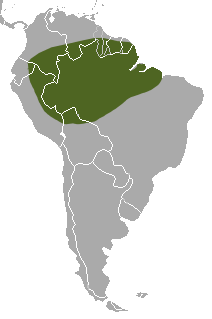Amazon weasel
| Amazon weasel | |
|---|---|
| Scientific classification | |
| Domain: | Eukaryota |
| Kingdom: | Animalia |
| Phylum: | Chordata |
| Class: | Mammalia |
| Order: | Carnivora |
| Family: | Mustelidae |
| Genus: | Neogale |
| Species: | N. africana |
| Binomial name | |
| Neogale africana (Desmarest, 1818) | |
 | |
| Amazon weasel range | |
| Synonyms | |
| Mustela africana | |
The Amazon weasel (Neogale africana), also known as the tropical weasel, is a species of weasel native to South America. It was first identified from a museum specimen mislabelled as coming from Africa, hence the scientific name.[2]
Taxonomy[edit]
Originally described in the genus Mustela, a 2021 study reclassified it into the genus Neogale along with two other former Mustela species, as well as the two species formerly classified in Neovison.[3]
Description[edit]
The largest of the three species of South American weasel, Amazon weasels measure 43 to 52 cm (17 to 20 in) in total length, including a tail 16 to 21 cm (6.3 to 8.3 in) long. They have a typical body form for weasels, with a long, slender, torso and short legs and ears. They have short fur which varies from reddish to dark brown on the upper body, and is pale orange-tan on the underparts. A stripe of fur the same colour as that on the upper body runs down the centre of the chest and throat. The whiskers are short and the soles of the feet almost hairless. Females have three pairs of teats.[2]
Distribution and habitat[edit]
Amazon weasels are known to inhabit the Amazon basin in northern Brazil and eastern Peru and Ecuador. However, the full extent of their range is unknown, and they probably also inhabit southern Colombia, Venezuela and the Guyanas, as well as northern Bolivia. The region is covered by tropical rainforest, and, while detailed habitat preferences are unknown, the weasel has mostly been recovered near rivers.[1][2]
Two subspecies are recognised:[2]
- N. a. africana (northeastern Brazil)
- N. a. stolzmanni (northwestern Brazil, Peru, Ecuador)
Biology and behaviour[edit]
The Amazon weasel is rarely seen and little is known of its habits. They eat rodents and other small mammals,[citation needed] and have been reported to construct burrows in the stumps of hollow trees.[4] They have been found from sea level to 1,250 m (4,100 ft),[2] and have been reported to swim in rivers or estuaries, sometimes far from the shore.[5]
References[edit]
- ^ a b Emmons, L.; Helgen, K. (2016). "Mustela africana". IUCN Red List of Threatened Species. 2016: e.T14025A45200982. doi:10.2305/IUCN.UK.2016-1.RLTS.T14025A45200982.en. Retrieved 14 March 2022.
- ^ a b c d e Ramírez-Chaves, H.E.; Arango-Guerra, H.L.; Patterson, B.D. (2014). "Mustela africana (Carnivora: Mustelidae)". Mammalian Species. 46 (917): 110–115. doi:10.1644/917.1.
- ^ Patterson, Bruce D.; Ramírez-Chaves, Héctor E.; Vilela, Júlio F.; Soares, André E. R.; Grewe, Felix (2021). "On the nomenclature of the American clade of weasels (Carnivora: Mustelidae)". Journal of Animal Diversity. 3 (2): 1–8. doi:10.52547/JAD.2021.3.2.1. ISSN 2676-685X. S2CID 236299740.
- ^ Emmons, L.H. (1997). Neotropical Rainforest Mammals, 2nd ed. University of Chicago Press ISBN 0-226-20721-8
- ^ Tate, G.H.H. (August 1931). "Random observations on habits of South American mammals". Journal of Mammalogy. 12 (3): 248–256. doi:10.2307/1373874. JSTOR 1373874.


 French
French Deutsch
Deutsch